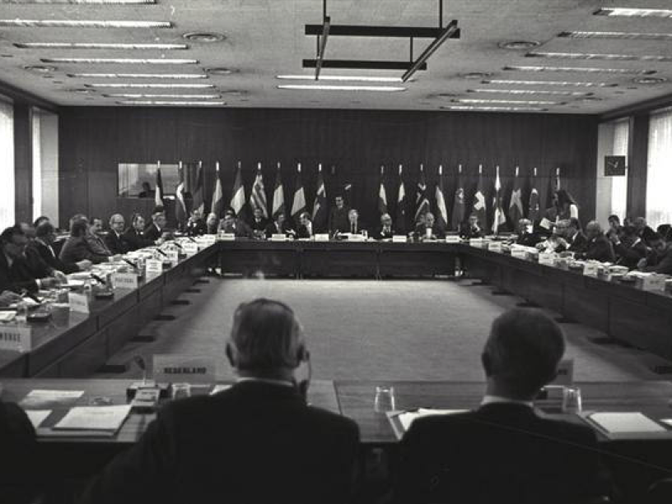

The Convention establishing ECMWF came into force on 1 November 1975, having been ratified by 13 countries. Today ECMWF has 21 Member States and 13 Co-operating States.
On the occasion of the Centre’s 40th anniversary, we look back at how ECMWF came to be set up and how it has changed since then.
How did the Centre come to be created?
The idea to set up something like a European meteorological centre can be traced to the sixties. In 1967, the Council of Ministers of the European Economic Community (EEC) asked a working group to examine the scope for co-operation in six fields, including meteorology.
It was soon agreed that co-operation should extend beyond the then six members of the European Communities.
The first President of ECMWF, Dr Erich Süssenberger, later noted that by the end of the decade “all agreed on a project for a medium-range weather forecasting centre – an issue close to the heart of all National Meteorological Services, but one they could not realise alone”.
A study concluded that the cost–benefit ratio of such a centre would be 1:20. In November 1971, EEC ministers confirmed the intention to establish the European Centre for Medium-Range Weather Forecasts.
The Convention, which was signed on 11 October 1973, set up the Centre as an independent international organisation. The only link with the European Union is that the documents confirming that states have joined ECMWF are “deposited in the archives of the General Secretariat of the Council of the European Communities”, now the EU.

Signing the Convention in 1973. See more photos on our History page.
What prompted the choice of location?
Several countries bid to host the Centre. In the end, the UK’s proposed site near Reading was chosen. It was close to a large university, to ensure an exchange of views on scientific developments, and to a national meteorological service (NMS), to keep the Centre informed of the practical work of the NMSs.
It was also felt that the site’s proximity to the London–Frankfurt–Paris triangle was an advantage.
Why was the Convention amended in 2010?
One reason was to enable states that had not been involved in drafting the original Convention to become members of the Centre. Iceland, Slovenia and Serbia have since become members.
Another reason was to expand the Centre’s mission. A key change was the specific inclusion of Earth system monitoring, a field which is now central to developments at ECMWF.
Other changes included the ability to run projects funded by third parties and to set up ‘Optional Programmes’ for activities that not all Member States wish to be involved in.
How has the Centre changed since 1975?
In many ways. Just consider this: In the early days, forecast charts were posted to most meteorological services. Today the Centre sends more than 4 terabytes of data every day to 277 destinations in 61 countries.
ECMWF has moved with and driven forward changes in the science and technology behind numerical weather prediction. It has pioneered techniques such as ensemble prediction and climate reanalysis. While the focus remains firmly on the medium range, the Centre now also produces extended-range forecasts for up to a year ahead.
Climate has become a critical issue, and ECMWF is playing its part. Reanalysis datasets available from the Centre provide a comprehensive assessment of the climate over the past 100 years, making a major contribution to climate studies. ECMWF is also operating the EU’s Copernicus Climate Change and Atmosphere Monitoring services.
Of course, none of this would be possible without a powerful computer system. ECMWF now operates one of the largest supercomputer facilities of its type in Europe and holds the largest meteorological data archive in the world.
More information on the history of ECMWF can be found in the book ‘Medium-Range Weather Prediction – The European Approach’ by Austin Woods (2006).
